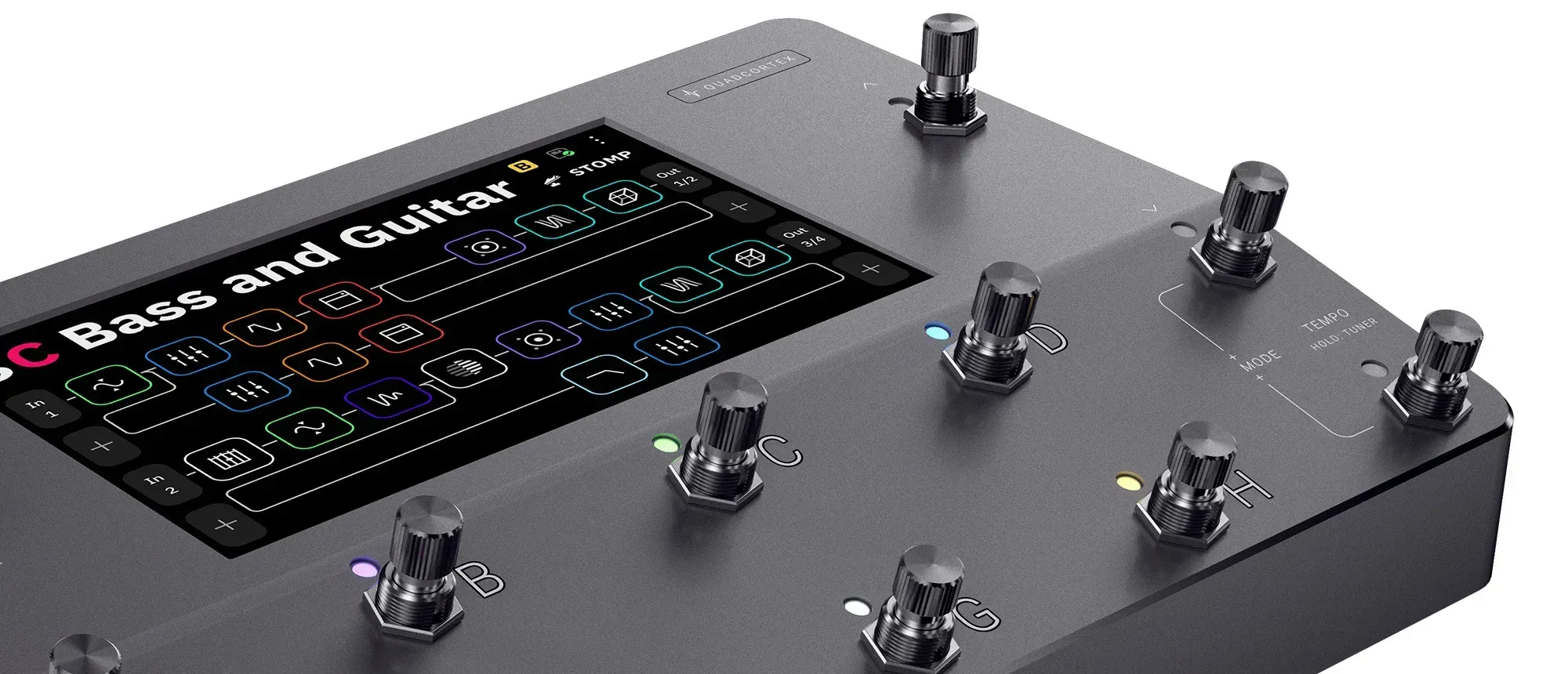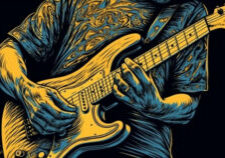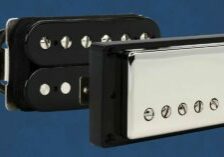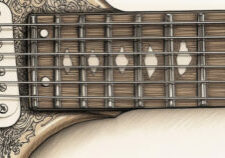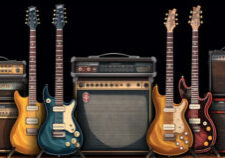Guitarists are always on the lookout for new gear to improve their sound and playing experience. The digital guitar modeler is one type of gear that has gained popularity in recent years. These devices allow guitarists to simulate the sounds of different amplifiers, effects pedals, and cabinets all in one unit.
Digital guitar modelers are a great option for guitarists who want to experiment with different sounds without having to invest in multiple pieces of gear. They are also useful for gigging musicians who want to streamline their setup and reduce the amount of gear they need to carry.
When choosing a guitar modeler, it’s essential to consider the quality of the digital simulations. Some models may have more accurate simulations than others, and the sound quality can vary depending on the model. It’s also important to consider the number of inputs and outputs, ease of use, and the ability to customize the settings.
In the following sections, we will highlight our top picks and provide a detailed analysis of their features and performance.
Complete Digital Guitar Modelers
This first category of modelers includes devices that generally are considered full-featured. This means that the device models every aspect of guitar amplification, including models of traditional, vintage and modern versions of:
- Tube amp heads
- Solid state amp heads
- Speaker cabinets
- Effects pedals
- Other multi-effects devices.
There are other modeling devices available that will just model amps or cabinets. It’s very common to find modeling devices that only model effects pedals. The complete digital guitar modelers below do it all! This way, you play any kind of tone you want without needing to plug in additional guitar gear.
Fractal Audio Axe-Fx III MKII Preamp/FX
Pros
- Top-of-the-line guitar processor that offers the latest in amp modeling technology and state-of-the-art effect algorithms.
- All-in-one solution for guitarists who want to achieve professional-level sound without the hassle of setting up multiple effects pedals and amplifiers.
- ARES amp modeling technology uses advanced algorithms to accurately reproduce the sound of classic and modern amplifiers.
- Over 250 different effect models, including distortion, modulation, delay, and reverb. These effects are all customizable, allowing you to create your own unique sound.
- Quad-core processor and 16GB of memory, which means it can handle even the most complex signal chains and effects.
Cons
- Extremely expensive without adding significant features compared to low-priced modelers.
- The UI could be improved. There’s a long learning curve to fully understand how to use this device and features.
Kemper Profiler Rack Rackmount Guitar Amplifier

Pros
- The Kemper Profiler Rack lets you create your own amp profiles, so you’re not limited to a bunch of preset models.
- With hundreds of profiled amplifiers available online, you’re sure to find the perfect tone for your music.
- The Kemper Profiler Rack is a great tool for both studio and live performances.
Cons
- The Kemper Profiler Rack is relatively expensive, so it may not be the best option for budget-conscious guitarists.
- Some users have reported that the Kemper Profiler Rack can be difficult to use at first, so there may be a bit of a learning curve.
- The Kemper Profiler Rack may not be the best option for guitarists who prefer a more traditional amp setup.
Neural DSP Quad Cortex Digital Effects Modeler
Pros
- Biomimetic AI technology can learn and replicate the sonic characteristics of any physical amplifier, overdrive, and cabinet with unprecedented accuracy.
- Capable of running up to four amp models simultaneously.
- Amp modeling is incredibly detailed, with a range of classic and modern tones available.
- Customize your own amp models to create unique sounds that suit your playing style.
- Wide range of customizable digital effects that includes delays reverbs, modulation effects, and more.
- Built-in profiler that allows you to capture the sound of your favorite amps and cabs.
- Neural DSP is known for having the most accurate digital amp simulation software in the industry.
Cons
- Still very expensive without adding significant features compared to low-priced modelers.
- Doesn’t have desktop software as of summer of 2023 (supposed to be in the works though)
Line 6 Helix LT Guitar Processor

Pros
- The Helix LT guitar processor delivers uncompromised Helix sound quality with 123 dB of dynamic range.
- With a streamlined I/O complement and hardware configuration, the Helix LT guitar processor delivers the highest levels of performance, flexibility, and control in its class.
- The award-winning HX Modeling engine leverages powerful dual-DSP performance to capture and recreate amps, cabs, mics, and effects with authenticity and responsiveness.
- This modeler is the best value for the high end optoins and its not even close. The Helix LT has incredible quality and full features for half the price of other modelers.
Cons
- The Helix LT processor is relatively expensive compared to the lower priced budget processors on the market.
- It is not as portable as some other guitar processors due to its size and weight.
- Though it has a good UI, it may be overwhelming for beginners due to its advanced features and capabilities.
NUX MG-30 Guitar Multi-Effects Pedal

Pros
- The NUX MG-30 offers a wide range of amp models and pedal effects, allowing you to create a diverse array of sounds.
- The amp modeling includes bias tweaking, allowing you to fine-tune each model’s tone to your liking.
- The interface is intuitive and easy to navigate, with a large, colorful LCD display and 11 independent moveable signal blocks.
- This has many features of the Helix, Kemper, Fractal & Neural DSP but at a much lower cost.
Cons
- The delays could be better, as they tend to sound a little thin and digital.
- The 1/4″ outputs don’t sound as good as the 1/8″ TRS output, so you may need to use an adapter or direct box to get the best sound quality.
- The build quality is decent but not quite as rugged as some other multi-effects pedals on the market.
Multi-Effects Guitar Modeler Pedals
The gear in this category may be missing some features that are common with complete modelers. Many of these devices will have effects but may not have amp models or cabinet IR models.
IK Multimedia TONEX Pedal

The Tonex is a bit different than other devices as the Tonex is a profiler. Users can record their amp, pedals and cabinets using the Tonex and the profile can be saved. The big benefit to the user is that you can access their tone models from the software library. Basically, if someone recorded a Marshall 1987 plexi amp with a Marshall 4×12 with Vintage 30’s, you could log into the Tonex library and install this on your Tonex device. This gives you thousands of options, but you are still limited to what amps and setups that other users decide to profile.
Pros
- New in 2023 and already a tremendous value. While it’s not a complete modeler, this is very high quality for the price.
- Access to 1000 premium TONEX Tone Models, each based on a famous amplifier for electric guitar, wah pedal, distortion pedal for electric guitar, overdrive pedal for electric guitar, or full pedalboard, you’ll have plenty of options to choose from to achieve your desired sound.
- High-quality profiling software rivals the profiling of many expensive modelers like the Kemper Profiler.
- The TONEX MAX Mac/PC software allows you to share unlimited user-created presets and model your own guitar effects pedal or guitar effects pedal board, all based on real gear.
- The built-in expression pedal and full MIDI I/O allow you to integrate with a looper guitar pedal, delay pedal, loop pedal, or other multi effects pedals for electric guitar for the ultimate pedalboard.
Cons
- The TONEX librarian for preset transfer/organization may take some time to get used to and could be a bit confusing for some users.
- While the sounds are great, the USB driver needed for software use only works on certain operating systems, which could be a problem for some users.
HOTONE Guitar Multi Effects Processor

Pros
- The 24-bit signal processing provides excellent sound quality with up to 127dB dynamic range.
- The 4-inch 800 x 480 dynamic touchscreen and newly designed UI make it easy to control and customize your effects.
- With up to 12 simultaneous effect modules and 300+ effects, including 87 amp models and 68 cab models, the upgraded effects library delivers a ton of tonal possibilities.
Cons
- The looper function only allows for a max of 60 seconds recording time, which may not be enough for some users.
- The footswitches can be a bit finicky and require a firm press to activate.
- The unit is a bit bulky and may take up more space on your pedalboard than other modelers.
Hotone Ampero MP-100 Guitar Bass Amp Modeling IR Cabinets Simulation Multi-Effects with Expression Pedal

Pros
- The 4-inch 800 x 480 sharp color touch screen provides instant control, making it easy to switch between different effects and amp models.
- With 198 presets and an adjustable signal chain with up to 9 simultaneous effect blocks, the Hotone Ampero MP-100 offers a lot of flexibility for creating your own unique sound.
- The Hotone Ampero MP-100 comes with a USB audio interface that supports stereo audio streaming and OTG function for directly connecting to iOS/Android mobile devices.
Cons
- The expression pedal is a bit small, which may make it difficult to use for some musicians.
- The Hotone Ampero MP-100 is a bit pricey compared to other guitar modelers on the market.
- The multi-language user interface may take some time to get used to.
Line 6 HX Stomp Multi-Effects Guitar Pedal

Pros
- The HX Stomp utilizes the same HX Modeling technology as the flagship Helix guitar processor, providing access to more than 300 effects and models from Helix, M-Series, and legacy Line 6 products.
- With up to 6 simultaneous amp, cab, and effect blocks (including a looper and IR loading), the HX Stomp is incredibly flexible and can be used as a “super stompbox,” a backup or travel rig, an add-on tone expander when combined with other modelers, an audio interface, or even a complete guitar or bass rig.
- The HX Stomp is easy to operate, thanks to its simple-but-powerful controls, 320 x 240-pixel color LCD, and capacitive-sensing footswitches with color-coded LED rings. External control via MIDI and optional expression pedal and footswitch control provide additional flexibility, as does I/O that may be configured for sophisticated routing such as simultaneously feeding an amp and a FOH mixer, 4-cable method operation with an amplifier, and studio re-amping.
Cons
- The HX Stomp can be overwhelming at first due to its vast array of features and options. It may take some time to learn how to use it effectively.
- While the HX Stomp is certainly compact, it’s still larger and heavier than some other guitar modelers on the market.
Line 6 POD Go Guitar Multi-Effects Pedal

Pros
- Simple interface with large color display
- Compact, ultra-portable, lightweight design
- 270+ HX and legacy amp and effects models
Cons
- No built-in wireless connectivity
- No built-in expression pedal
HeadRush MX5 – Electric Guitar Multi Effects Pedal and Amp Modeling Processor

Pros
- The touch display is easy to use and highly responsive, allowing you to quickly and easily create and edit your tone.
- The extensive library of amp models, cabinets, microphones, and effects gives you a huge range of sounds to choose from.
- The built-in looper and audio interface make it easy to record and play back your performances.
Cons
- The expression pedal is a bit small and may be difficult to use for some players.
- The looper has a slight delay when starting and stopping, which can be frustrating.
- The pedal is relatively heavy and may not be ideal for gigging musicians who need to travel light.
Boss GT-1000CORE Multi-effects Processor Guitar

Pros
- The full DSP muscle of the flagship GT-1000 lives inside this mini juggernaut, driving class-leading sound quality, advanced AIRD technology, 24 simultaneous effects blocks, and over 140 unique amp/effect types for unlimited creative expression.
- GT-1000CORE fits into any pedalboard setup and works equally well as a standalone processor for playing live and in the studio.
- It has dual FX loops and stereo 1/4-inch inputs.
Cons
- The amps all sound the same, and in some cases, overly bright. However, with some tweaking, they can be dialed in to be responsive and fun to play.
- The user interface isn’t nearly as straightforward as other modelers on the market, so there is a bit of a learning curve.
- Customizing any effects can be a bit difficult for beginners.
Zoom G11 Guitar Multi-Effects Processor

Pros
- The app-based touchscreen interface is easy to use and allows for intuitive control of the G11’s many features.
- The new Zoom Amp Models combine the tonal qualities of classic amps, providing a wide range of sounds to choose from.
- The 5-minute looper and 68 rhythm patterns are great for practicing and jamming.
Cons
- The G11 does not have any XLR outputs, which may be an issue for some users.
- The presets can be limited and boring, but this can be remedied by creating your own custom presets.
- The G11 is a bit on the heavy side, weighing in at 9 pounds.
MOOER GE300 Amp Modelling, Multi Effects, Guitar Synth Pedal

Pros
- Dual-DSP processors for detailed sound
- 108 digital amp models based on real-life tube amplifiers
- Tri-voice polyphonic synthesizer module for added creativity
Cons
- Software may need updates
- Pitch shifter is limited
- Limited chain of effects
Strymon Iridium Amp and IR Cab Simulator Pedal

Pros
- The Iridium offers three iconic amplifier models crafted using Matrix Modeling, capturing the subtleties and unique tonal qualities of each amp.
- The pedal has a simple, responsive amp-style controls for Drive, Level, Bass, Middle, and Treble, making it easy to dial in your desired tone.
- The Iridium features a hybrid IR/algorithmic Room control with selectable small, medium, and large rooms, allowing you to add lush room ambience to your tone.
Cons
- The pedal is a bit expensive compared to other amp and cabinet simulation pedals on the market.
- Some users have reported poor sustain, even at the highest gain.
- The Iridium requires a 9V DC power supply with a minimum of 500mA of current, which may not be readily available for some users.
Frequently Asked Questions
How do guitar modelers differ from traditional amps?
Guitar modelers are digital devices that simulate the sound of different amplifiers and effects pedals. They differ from traditional amps in that they do not rely on physical components to create sound. Instead, they use digital signal processing (DSP) to model the sound of classic amps and effects. This makes them much more versatile than traditional amps, as they can simulate a wide range of sounds and effects.
What is a guitar floor modeler and what are the benefits of using them?
Most of the digital guitar modelers on this page are floor modelers. Some
One of the main benefits of using a guitar floor modeler is the ability to have a wide range of sounds and effects at your fingertips. With a modeler, you can switch between different amp models, effects pedals, and even speaker cabinets with ease. This makes it much easier to experiment with different sounds and find the perfect tone for your playing style.
Another benefit of using a guitar floor modeler is the ability to save and recall presets. This means that you can save your favorite settings for different songs or playing situations and recall them with the press of a button. This can save you a lot of time and hassle, especially if you play in a band and need to switch between different sounds quickly.
Can a guitar floor modeler be used for live performances?
Yes, guitar floor modelers can be used for live performances. In fact, many professional guitarists use modelers as their main source of amplification. Modelers are often more reliable than traditional amps, as they are less prone to breaking down or malfunctioning. They are also much easier to transport, as they are usually lighter and more compact than traditional amps.
What are some key features to look for in a guitar floor modeler?
When shopping for a guitar floor modeler, there are several key features to look for. First, you’ll want to make sure that it has a wide range of amp models and effects pedals to choose from. You’ll also want to look for a modeler that is easy to use and has a user-friendly interface.
Another important feature to look for is the ability to save and recall presets. This can save you a lot of time and hassle, especially if you play in a band and need to switch between different sounds quickly. Finally, you’ll want to look for a modeler that has a rugged and durable construction, as it will likely be subjected to a lot of wear and tear over time.


